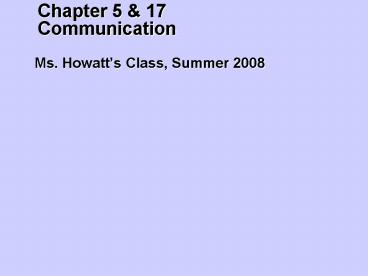Chapter 5 - PowerPoint PPT Presentation
1 / 25
Title: Chapter 5
1
Chapter 5 17Communication
- Ms. Howatts Class, Summer 2008
2
Topics
- Why are listening and questioning skills
important? - How can salespeople develop listening skills to
collect information about customers? - How do people communicate without using words?
- What are the barriers to effective communication?
5-1
3
The Communication Process
Exhibit 5.1
Message
Encodes
Receiver
Sender
Decodes
Feedback
- Noise includes-
5-2
4
Modes of Communication
5
Making Verbal Communication Effective Effective
Use of Words
Use concrete rather than abstract words.
- Which is more effective?
- We ship orders quickly.
- We ship orders within 24 hours after receiving
them.
6
Making Verbal Communication Effective Effective
Use of Words
Dont use words that trigger fear
7
Making Verbal Communication Effective Effective
Use of Words
Paint word pictures.
5-6
8
Making Verbal Communication Effective Effective
Use of Words
Tailor your words to the customers preferred
communication style.
5-7
9
Making Verbal Communication Effective Modify
Your Voice
Can you demonstrate the differences in these
voice characteristics?
- Speech rate
- Loudness
- Articulation
5-8
10
Guidelines for Asking Questions
Use open-ended questions
- Open questions encourage customers to speak
freely. - Since there are no simple answers, these
questions encourage longer responses.
5-9
11
Guidelines for Asking Questions
Use closed-ended questions judiciously.
- Closed-ended questions can be answered with a
word or short phrase. - Closed-ended questions pin down specifics and
confirm understanding.
5-10
12
Guidelines for Asking Questions
Space out questions.
- When salespeople ask several questions, one right
after another, customers may feel threatened.
5-11
13
Guidelines for Asking Questions
Avoid leading questions
- Questions should not suggest an appropriate
answer. - Try to draw out what the customer actually thinks.
5-12
14
Guidelines for Asking QuestionsAsk questions to
maintain information flow.
Ask questions to maintain information flow
- Use brief verbal responses, such as Really?,
Uh-huh, or Thats interesting. - Use requests for additional information, such as
Can you give me an example of what you mean?
5-13
15
Guidelines for Asking QuestionsAsk questions to
collect information.
Ask questions to collect information
- These questions usually start with who, what,
where, when, why or how.
5-14
16
Suggestions for Active Listening
- Repeat information
- Restate or rephrase information
- Clarify information
- Summarize the conversation
5-15
17
Non Verbal Communication, why important?
- In face to face- ___ from words, ___ from tone
(how you say it), ___ from non-verbal - 3 forms of Non verbal
18
Reading the Customers Non-Verbal
Communication-3 forms
- Body angle
- Face
- Arms
- Hands
- Legs
5-17
19
Patterns of Nonverbal Reactions to Presentation
5-18
20
Other Negative
- Bored
- Let me go!
21
Sending Non-Verbal Communication
- Body language
- Eye contact
- Hand movements
- Posture and body movements
- Matching customers communication style
5-20
22
Distance Zones for Interaction
- Intimate zone
- 0-2 feet
- Personal zone
- Social zone
- Public zone
- More than 12 feet
5-21
23
Dress for Success Men
- In general, darker suits give a more
authoritative image lighter colors create a
friendlier one. - Pinstripes convey the most authority, followed by
solids. - Solid white shirts or shirts in pastel colors.
- Let the tie provide the accent color.
5-22
24
Dress for Success Women
- Navy, black, and gray suits worn with
light-colored blouses are part of any wardrobe. - Add suits in more cheerful shades, wool or silk
dresses with jackets, and blazers with
coordinated skirts. - Silk scarves can add flair and a touch of color.
- Hairstyle should be subtle and comfortable.
5-23
25
Adjusting for Cultural Differences
- Use of Language-simple
- Use common English words
- Use words with fewest alternative meanings
- Avoid slang
- Use proper rules of grammar
- Use action-specific rather than action-general
verbs - Time and Scheduling
5-24

